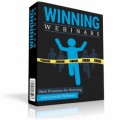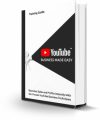Table of Contents
INTRODUCTION 4
WHY INBOUND? 6
HOW TO “MAKE THE PHONE RING”? 11
DIFFERENT WAYS TO GET YOUR CUSTOMERS TO COME FIND YOU 11
KNOW YOUR CUSTOMERS – KNOW YOUR TARGET AUDIENCE 13
ATTRACTING NEW LEADS SHOULD BE A DAILY PRIORITY 15
FREE VS. PAID “FUEL” FOR YOUR FUNNEL 15
QUALIFY YOUR PROSPECTS AS SOON AS POSSIBLE 16
MAP OUT A FUNNEL 17
CAST YOUR NET FAR & WIDE 19
GET THEM EXCITED TO BUY FROM YOU 20
USE TAGGING TO SEGMENT YOUR LIST 21
TEST AND TRACK EVERYTHING – THAT’S HOW YOU’LL GET BETTER 22
CONCLUSION 23
Sample Content Preview
Why Inbound?
Inbound marketing is simply the way we do business most of the time in this age of Social Media and Google. Let’s start with a little definition. Inbound sales refer to sales and marketing you do where the customers find you and then get in touch in one way or another to learn more about what you and your business do. The end goal is of course to turn these prospects into paying customers – ideally repeat customers.
Inbound sales isn’t a completely new idea. Back in the day it used to be called word of mouth advertising. Before the internet, this left us with a fairly limited reach and slow growth. To grow faster and get more leads into the sales funnel, businesses would rely on outbound marketing like most traditional advertising channels to gain their customers. The internet and content marketing have changed the game. Today inbound marketing is a much better play and frankly a better way to attract customers. No one likes to be cold called and sold to. But we are all on Facebook and Google each day actively searching for information, products, and solutions. The goal with inbound marketing is to make sure you and your business are there when those searches are made.
In other words, instead of spending thousands of dollars in advertising both online and offline, or paying for direct mailers, you’re creating and sharing lots of content in a variety of formats so your future clients can find you.
In the introduction we briefly talked about inbound and outbound phone calls to explain the difference between inbound and outbound sales. Let’s look at that in a little more detail and how it translates into online sales.
Outbound calls are calls where you, the sales person, call a list of numbers, hoping to come across a potential customer. Often you don’t know much about the person you’re calling and you have no way to qualify if they’d make a good prospect before making the call. And of course you have no idea if the person you’re calling is even remotely interested in what you have to offer right now.
Let’s say you work for a car dealership and are making outbound calls to try to sell a new car. You have no idea if the people you’re calling are in the market for a new car right now. That makes finding the right prospect and closing the sale a pretty tough proposition.
An inbound call on the other hand is when the customer calls you. He or she has learned about you through various advertising methods or word of mouth and is calling you when they are ready for what you have to offer. Going back to the car dealership example, this is when a potential customer calls you with questions about a particular car, or wanting to set up a test drive. Here the chances of making a sale are much higher.
The same principles hold true in marketing with inbound and outbound techniques. In a lot of cases it depends on what you share and how you advertise to determine if it’s an inbound or outbound sales campaign. Let’s run through a couple of examples.
• If you craft a blog post or article for your website that answers a question your potential clients have and get it to rank in the search engine, it is inbound marketing.
• If you’re paying to advertise your product on someone else’s website, it’s outbound marketing.
• You’re interacting in a Facebook group making connections with potential clients and sharing links to your website, where they can sign up for your list etc. – inbound marketing.
• You’re posting on your Facebook page, boosting your post to get it in front of as many people as possible – outbound marketing.
Inbound marketing is all about spreading great content far and wide and doing what you can to make people aware of you and your brand. When they are good and ready, they’ll come to you and sign up for your list, learn from you and eventually buy from you. Your goal is to get in front of interested people and draw them into your funnel.
Yes, sometimes that will involve paid advertising methods, but the main goal is to get your content out there and establish yourself as the go-to expert. Your job is to get in front of your target audience and capture their attention. The next move is up to your potential customer. They choose to sign up for your list, like your Facebook page, follow your blog, or buy from you. Your job is to get in front of them and impress them with your content. You don’t really start to market to them until after you have them in your funnel.
There’s a reason there’s a much bigger focus on drumming up inbound sales than making outbound sales – they work better. You don’t waste your time getting your offer in front of people who are not interested in what you have to sell. Instead, you’re using targeted content to attract highly qualified leads that are ready to get on your list, follow you on Facebook, and hopefully buy from you in the near future.
This technique is also sometimes called a soft sell. You warm them up with lots of helpful tips, give them a chance to get to know you before you close the sale. Again this is much easier and more effective than going out there cold calling and making offers.
But the benefits don’t stop there. With this inbound marketing method, you’re out there building a relationship with your audience. They get a chance to get to know, like, and trust you. Not only will this help you close more sales, you are also building an asset.
Let’s say one of your first goals when you’re out there marketing your content is to get people on your list. You now have a list of interested people that you can approach with offers over and over again. Not only can you sell them the product you just launched, but also future related products you have in production. And what about other people’s products? That’s right, you can sell them related products, make other offers, and collect a nice little affiliate commission along the way.
That’s not possible with outbound marketing. If you make an offer to a cold target and they decline, that’s it. End of story. If you use inbound marketing and get them into your funnel first, you can still profit from this lead, even if the product you have to offer isn’t the right fit for them. You simply look around and offer them something else. Sooner or later they will buy and either way you end up improving your bottom line.
Having this list of “warm leads” also gives you a lot of leverage when it comes to doing JVs and cross promotions. Let’s say you teach a course on list building that mainly focuses on Facebook ads to grow the list. You build a list of people who are very interested in growing their list. Some will get your product, but some may not be interested in giving Facebook ads a try. But you have a fellow marketer with a brand new course on growing a list by hosting free webinars. Maybe that’s more what some people on your list are looking for. Similarly, the list the other marketer built has people on it who are scared of doing a live Webinar. You agree to cross promote to each other’s lists and everyone wins. You and the fellow marketer make more sales, you each collect a nice affiliate commission, and your subscribers find the solution they need to move forward with growing their own lists.
Since you can profit from your leads in multiple ways, it’s a lot more cost effective to work on inbound marketing. Yes, even if you focus mainly on “free” content marketing strategies, there’s a cost associated with inbound marketing. You may not have a big advertising budget and you’re not paying for cold leads, but you’re spending a lot of time and effort creating and spreading all this free content that attracts your inbound leads. And your time and expertise are worth something.
Or maybe you’re at a point where you need more marketing materials and content than you can create yourself (hint – that’s a good thing). You outsource some of the article writing, blogging, and social media activity to a small team of writers and VAs. That definitely has a cost associated with it.
That being said, dollar for dollar, it is usually quite a bit more cost effective to do inbound marketing, if you do it right. How to do it right is something we’ll talk about extensively in the rest of this eBook. In fact, we’re not just going to cover how to do it right, but also how to get better and better at it.
Other Details- 10 Articles (PDF)
- 1 Ebook (PDF), 24 Pages
- Check List, Mini Report, Quote Poster, Infographic,
- Year Released/Circulated: 2016
- File Size: 6,464 KB
License Details:
[YES] For you own personal use
[NO] RESELL IN ANY WAY












